The importance of popup conversions cannot be overstated in the digital marketing landscape. These seemingly simple tools are pivotal for driving various key website actions, from signing up for newsletters to closing sales. Understanding and optimizing popup conversions are essential for maximizing the effectiveness of your marketing strategies.
Key metrics for measuring popup success include conversion rate, click-through rate, and overall ROI. These metrics help determine not just the effectiveness of a popup campaign but also provide insights into user behavior and preferences.
Popups are not just about capturing attention, they are about capturing interest in a way that aligns with user needs and business goals
Understanding Popup Conversions
What is a Popup Conversion?
A popup conversion occurs when a visitor completes a specific action that the popup intended to prompt. This action could be as simple as subscribing to a newsletter or as significant as completing a purchase. The effectiveness of a popup is directly measured by its conversion rate—the percentage of users who take the desired action relative to the number of people who see the popup.
3 Different Types of Conversions (Sign-ups, Sales, Engagements)
Sign-ups: Often used for gathering email addresses or registering users for a free trial. The success of these popups is measured by how many visitors convert into subscribers or registered users.
Sales: Aimed at encouraging purchases directly from the popup, often through special offers or discount codes. These are crucial for e-commerce sites looking to boost transaction rates.
Engagements: These include actions like downloading a resource, taking a survey, or participating in an event. Engagement popups are designed to deepen the visitor's interaction with the site.
The Psychology Behind Popup Effectiveness
Understanding the psychological triggers that influence user behavior is crucial for designing effective popups. By tapping into these psychological aspects, you can significantly enhance the impact of your popups.
Psychological Triggers in Popups
Urgency: Creating a sense of urgency can compel users to act quickly. Phrases like "Limited time offer" or "Only a few left" prompt immediate action.
Curiosity: Humans are naturally curious. A well-crafted teaser can encourage users to uncover more, leading them to engage with the popup.
Fear of Missing Out (FOMO): This powerful motivator can drive users to participate in something that they perceive as time-sensitive or exclusive to avoid missing out.
How Urgency and Scarcity Affect Conversions
Urgency: By setting a time limit on offers, you can speed up the decision-making process and increase conversion rates. Users feel the need to act fast to take advantage of the offer.
Scarcity: Limiting the availability of an offer can make it seem more valuable. This perceived increase in value can make the offer more desirable, thus boosting conversions.
3 Elements to Keep in Mind While Designing Converting Popups
Creating popups that convert effectively involves more than just displaying an offer. The design and presentation of your popup play crucial roles in attracting attention and encouraging users to take action.
1. Key Elements of High-Converting Popup Designs
Simplicity: A clutter-free design focuses user attention on the message and the call to action (CTA). Keep the design simple yet appealing.
Visibility: Ensure that the popup stands out without being overwhelming. Use colors and fonts that align with your brand but also draw attention.
Accessibility: Design your popup so that it's easily readable and accessible on all devices, especially mobile, where a significant amount of web traffic originates.
2. Color Psychology and Its Impact on Conversions
Color psychology plays a pivotal role in how users perceive your popup. For example:
Red: Often associated with urgency and excitement, red can be effective for clearance sales or limited-time offers.
Blue: Conveys trust and stability, making it a good choice for services or subscription sign-ups.
Green: Typically associated with health, peace, and positivity, green is effective for wellness products or eco-friendly initiatives.
3. Designing for Different Audiences
Tailor the design of your popups to match the preferences and behaviors of your target audience. Consider factors like:
Age: Younger audiences might respond better to vibrant, dynamic designs, while older users may prefer clarity and straightforwardness.
Cultural Factors: Colors and imagery should be chosen with cultural context in mind to ensure they resonate positively and avoid cultural missteps.
Crafting Compelling Copy
Effective popup design captures attention, but it's the copy that convinces users to take action. Mastering the art of writing compelling popup content can significantly boost your conversion rates.
Writing Headlines That Capture Attention
Clarity and Brevity: Headlines should be concise and clear. Users should understand the offer at a glance.
Use of Power Words: Words like "Free," "Guaranteed," "Exclusive," and "Limited" can trigger emotional responses and drive action.
Question Headlines: Pose questions that resonate with the viewer's potential interests or needs, prompting them to think about how your offer fits into their life.
Effective Calls-to-Action: Language and Placement
Action-Oriented Language: Use verbs that inspire action, such as "Get," "Start," "Join," or "Discover."
Contrasting Colors: Make your CTA button stand out with colors that contrast with the rest of the popup but still fit within your brand palette.
Placement: Ideally, place the CTA button where it’s easily visible without scrolling, often at the bottom of the popup after the message.
Tips for Writing Short, Persuasive Popup Text
Focus on Benefits: Quickly communicate what the user stands to gain from taking action. Highlighting benefits rather than features can better connect with users' desires.
Create Urgency: Without resorting to pressure, suggest that acting now is beneficial (e.g., “Join today to start enjoying exclusive benefits immediately”).
Testimonials or Social Proof: Include a short customer quote or statistic that reinforces the value of the offer and builds trust.
Timing and Placement of Popups
The effectiveness of popups not only depends on their design and copy but also significantly on when and where they appear on the user's screen. Proper timing and strategic placement are crucial for maximizing engagement without disrupting the user experience.
Determining the Best Time to Show Popups
Delay Timers: Set a delay on your popup so it appears after a user has been on your site for a specified period, allowing them to engage with your content first.
Behavior-based Triggers: Implement popups based on user actions, such as scrolling to a certain point, hovering over a specific element, or showing signs of exiting the page.
Strategic Placement for Maximum Exposure
Center Screen: Most common and generally effective, center screen popups capture immediate attention.
Sidebar: Less intrusive, sidebar popups can be effective for longer engagement times as they allow users to continue viewing the page content.
Bottom Bar: Often used for notifications or calls to action, these remain visible as the user scrolls, providing a constant reminder without taking up too much screen space.
Utilizing Exit-Intent Technology
Capturing Last-Moment Engagement: Exit-intent technology detects when a user is about to leave your site and triggers a popup at that precise moment, offering a chance to convert them before they go.
Offering Special Deals or Reminders: This can include discounts, reminders about items in the shopping cart, or an invitation to subscribe to newsletters, effectively reducing cart abandonment and increasing subscriber lists.
Targeting and Personalization
Personalizing popups based on user behavior and segmenting audiences can dramatically increase the effectiveness of your campaigns by presenting the most relevant offers to the right users at the right time.
Importance of Audience Segmentation
Demographic Targeting: Tailor popups to user demographics such as age, gender, location, or language to increase relevance and engagement.
Behavioral Targeting: Customize offers based on user actions like past purchases, viewed pages, or interaction history on the site.
Personalizing Popups Based on User Behavior
Dynamic Content: Adjust the content of popups dynamically based on the user's navigation path or engagement level to offer a more personalized experience.
Retargeting: Use cookies to track users who did not convert on their first visit and present them with tailored popups on subsequent visits to encourage conversion.
Tools and Techniques for Dynamic Content
Data Integration: Utilize data from your CRM or analytics tools to segment users effectively and tailor popups accordingly.
A/B Testing: Continuously test different versions of personalized popups to refine targeting strategies and improve conversion rates.
Creating High Converting Popups with Poper
Poper offers a versatile platform for designing and deploying effective popups, with a focus on ease of use and integration. Here’s how you can leverage Poper to create customized popups that resonate with your audience.
Overview of Poper’s Popup Builder Features
Poper’s popup builder is designed with user-friendliness in mind, offering a range of customizable templates and interactive features that can be tailored to fit any marketing strategy. The platform supports various types of popups, including lightbox, slide-in, and banner popups.
Step-by-Step Guide to Creating Conversion Rate Optimizer Popups
Starting Your Popup:
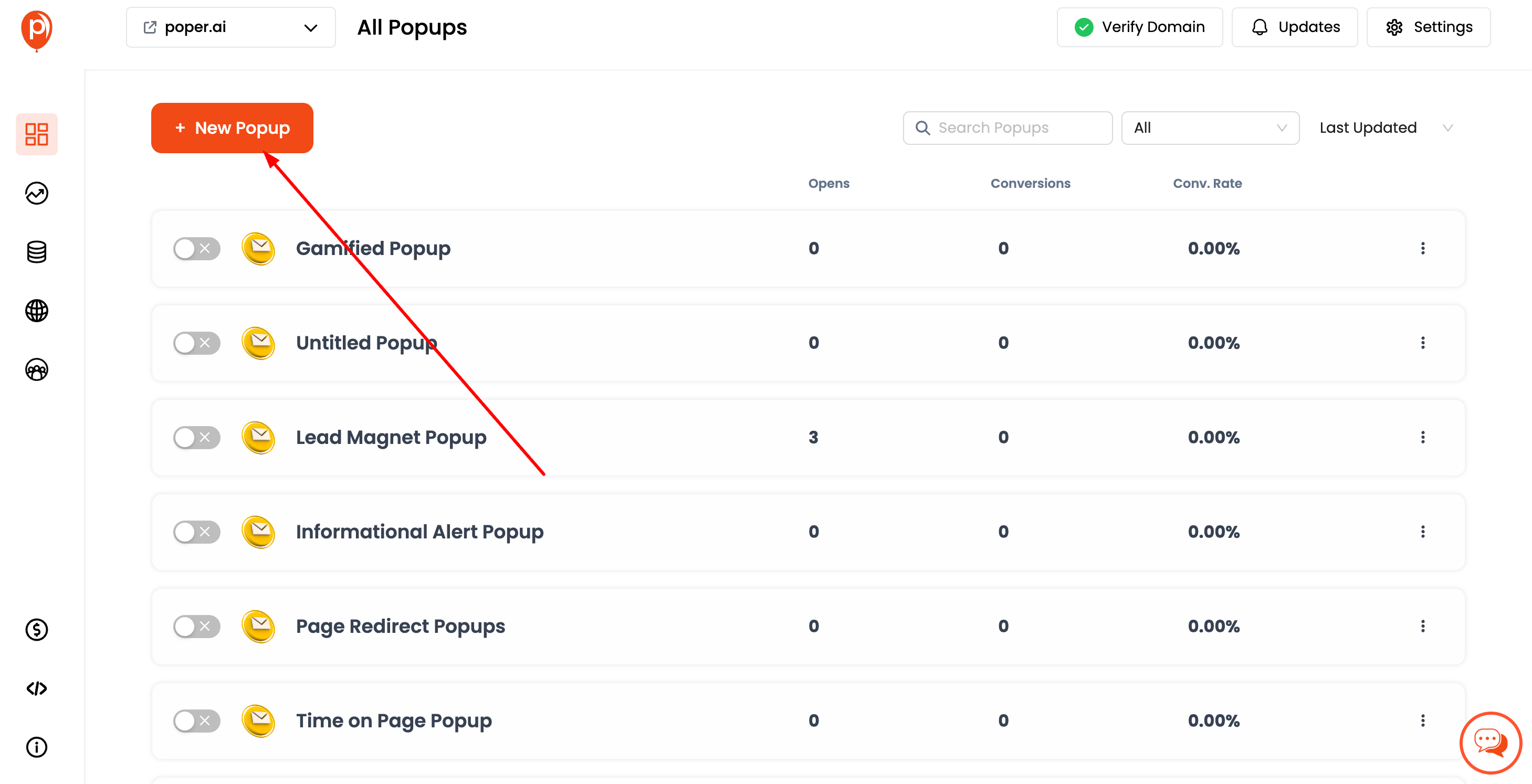
Access Poper and navigate to the dashboard to begin creating a new popup specifically designed to optimize conversion rates.
Choosing Your Creation Method:
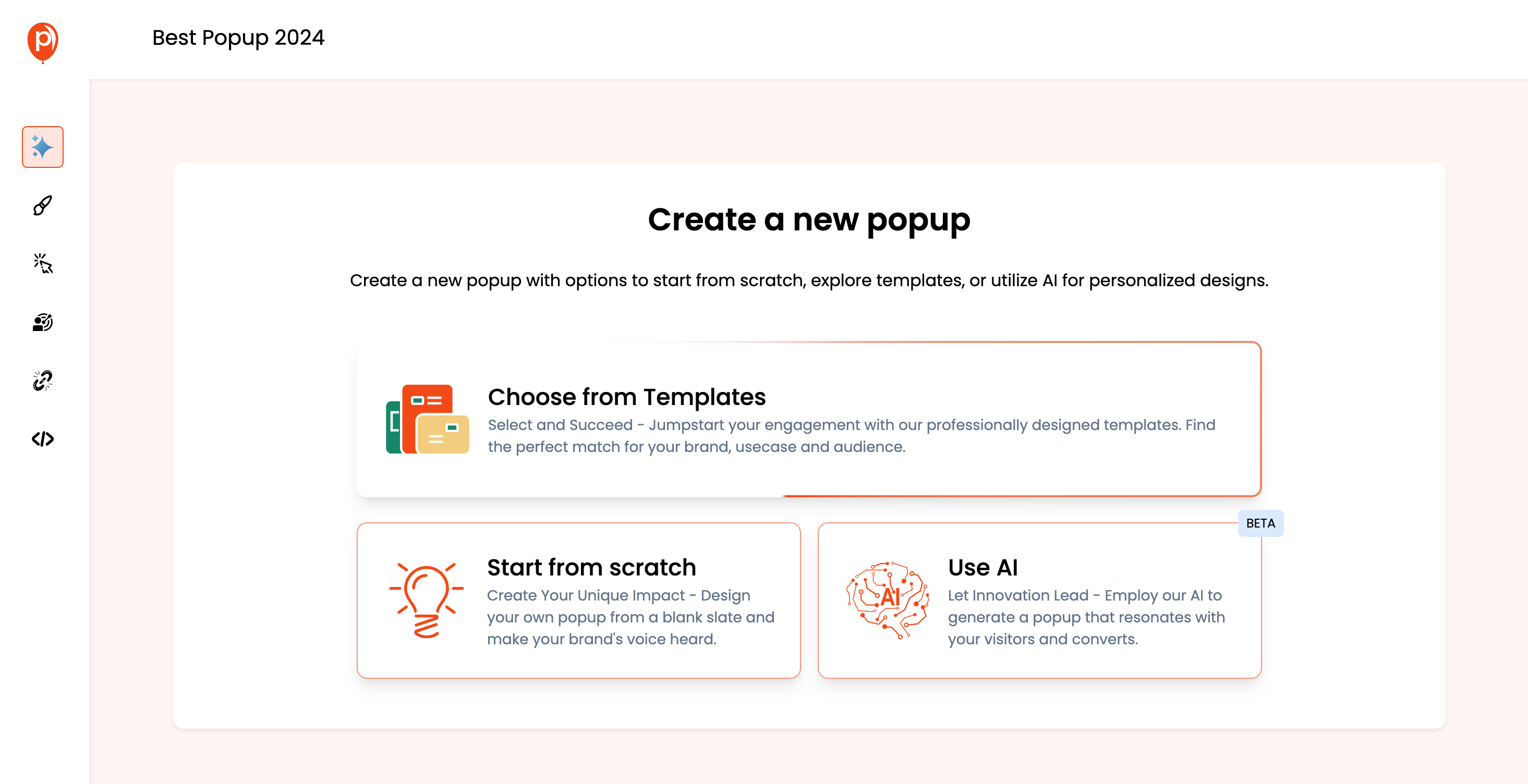
Select from a variety of methods:
- Use predefined templates tailored for high conversions.
- Start from scratch if you have specific design ideas.
- Leverage AI to create personalized designs that adapt to user behavior and preferences.
Use predefined templates tailored for high conversions.
Start from scratch if you have specific design ideas.
Leverage AI to create personalized designs that adapt to user behavior and preferences.
Template Selection:
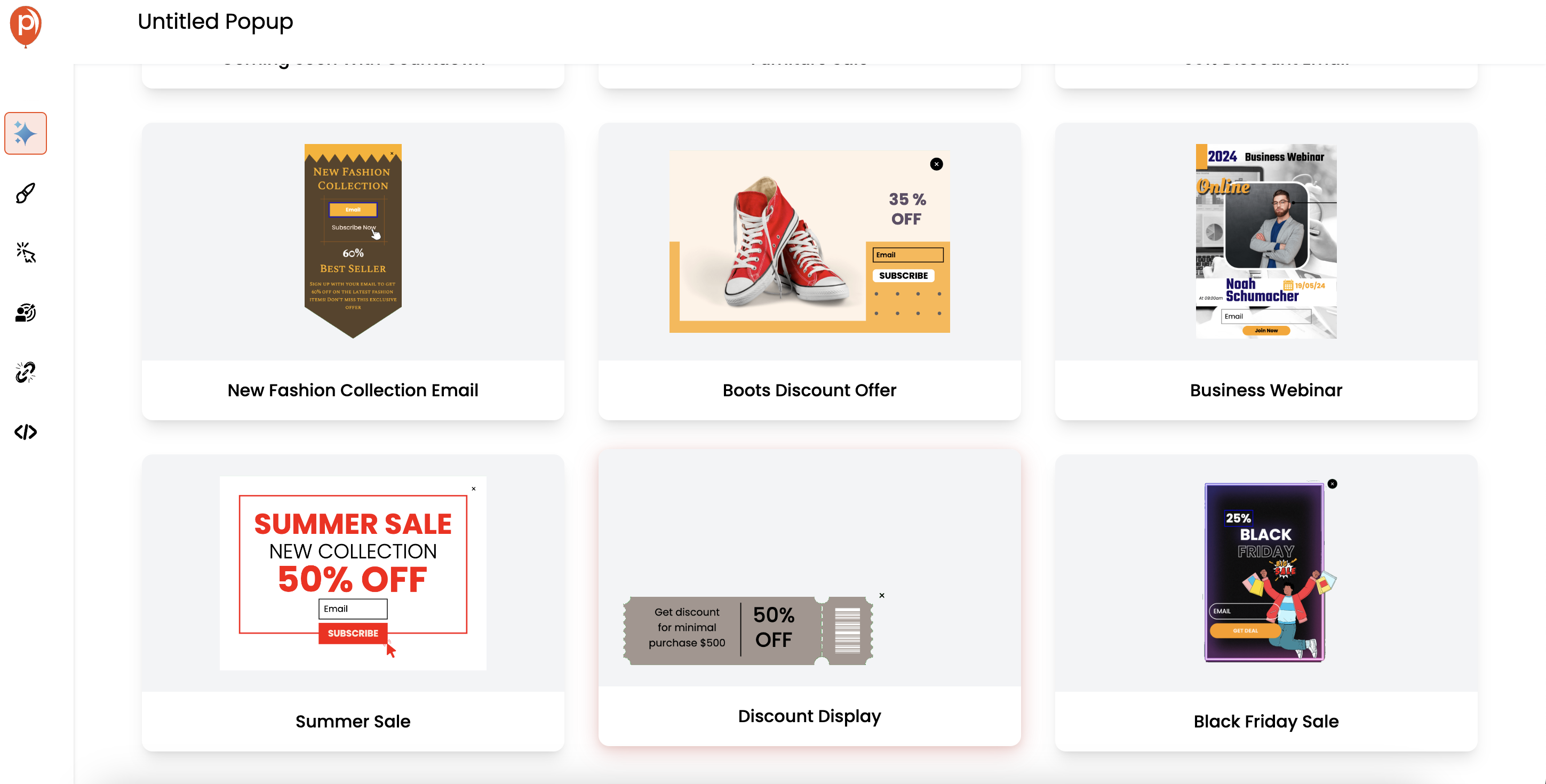
Browse through a selection of templates proven to boost conversions. Choose one that aligns with your marketing goals and brand identity.
Customizing Your Popup:

Customize the chosen template by editing text, colors, and graphics to match your brand’s style and the campaign’s message.
Adjust interactive elements to engage visitors effectively.
Setting Display Triggers:

Configure when and how your popup should appear to visitors. Options include triggers based on time spent on the page, scroll depth, or exit intent.
Audience Targeting and AI Filtering:
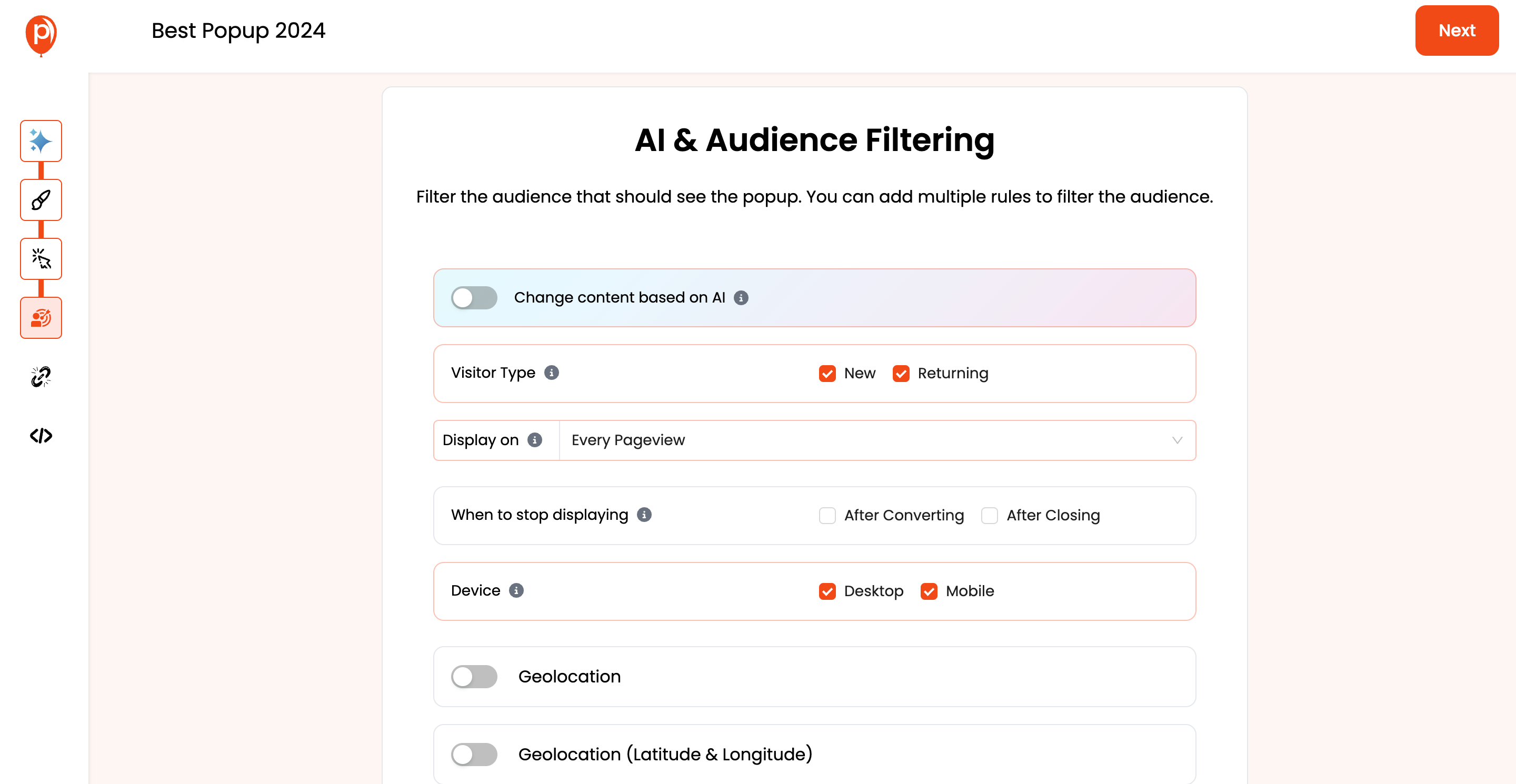
Apply filters to ensure the popup is shown to the most relevant audience. Use AI enhancements to adapt content dynamically based on visitor data such as new vs. returning, device type, and geographic location.
Integration with Marketing Tools:

Connect the popup with other marketing tools like email marketing platforms or CRM systems to streamline your workflow and enhance the effectiveness of your campaigns.
Publishing Your Popup:
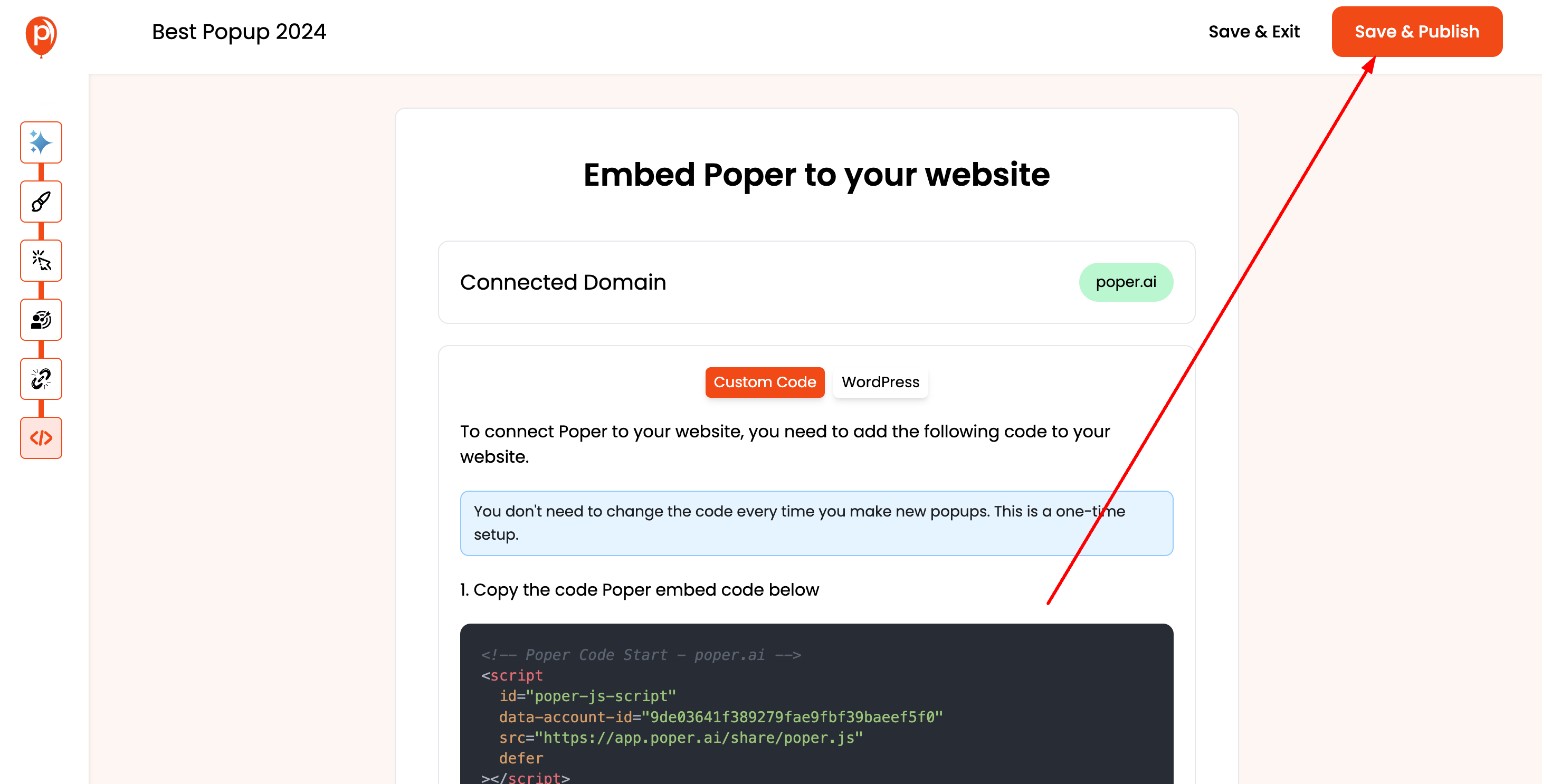
Once your popup is ready, publish it to start seeing improvements in engagement and conversions.
Ensure your popup is mobile-optimized and loads quickly to maintain a positive user experience.
Analytics and Optimization:
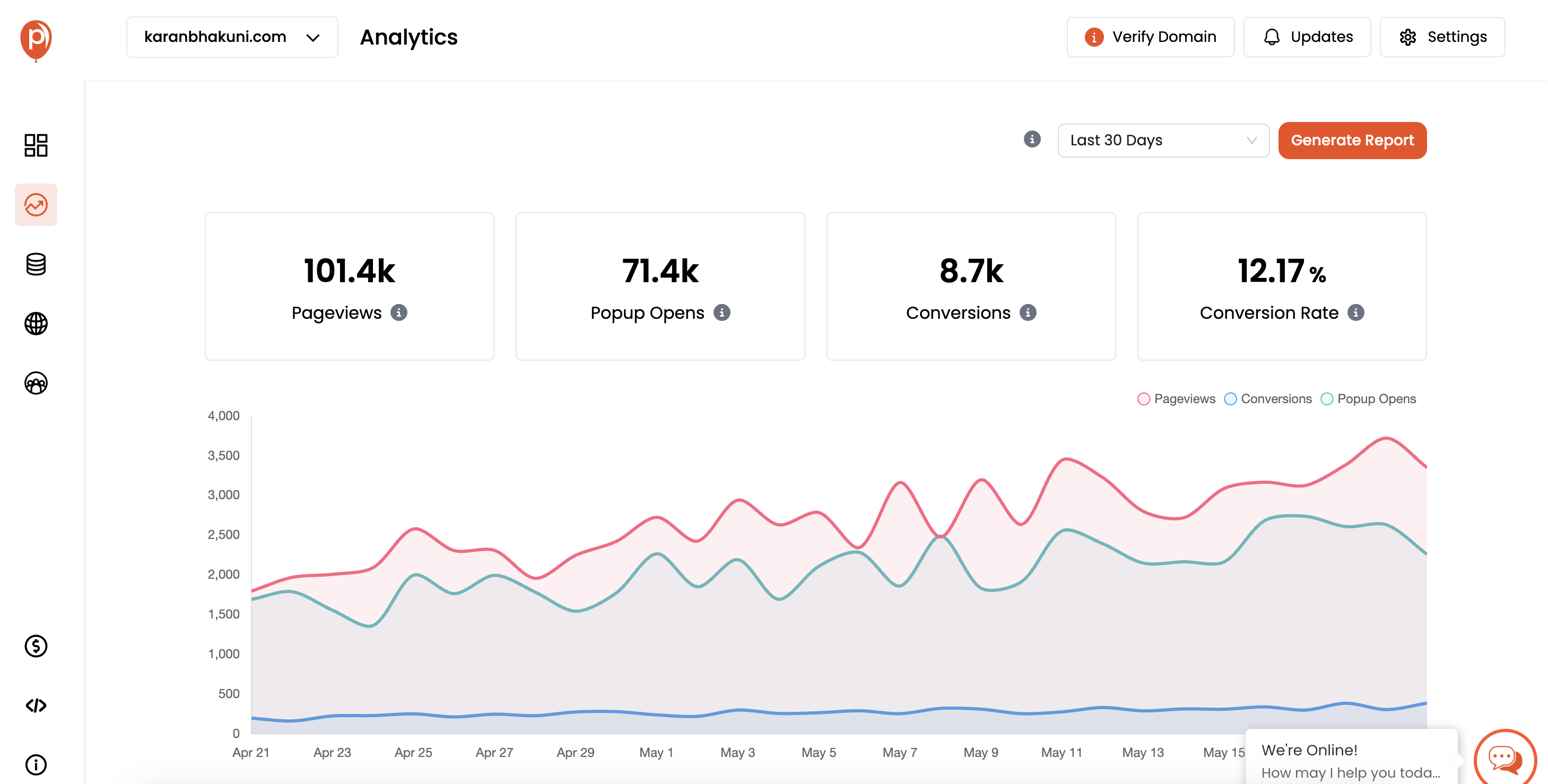
Monitor the performance of your popup through Poper’s analytics dashboard. Track metrics such as pageviews, popup opens, and overall conversion rates.
Use these insights to refine your approach and continuously improve the effectiveness of your popups.
Managing Leads

Download and analyze the leads generated from your popups. Assess the quality of leads and the success of your targeting strategies to further refine your conversion tactics.
User Experience and Popup Interaction
Enhancing user experience is pivotal when implementing popups, as a positive interaction can significantly increase the likelihood of conversion while minimizing potential irritation.
Minimizing User Annoyance with Smart Popup Practices
Non-Intrusive Timing: Introduce popups at natural interaction points or after the user has demonstrated interest by engaging with the content for a significant time.
Easy Dismissal Options: Ensure that closing the popup is straightforward and clear, preventing user frustration and potential site abandonment.
Frequency Capping: Limit how often a user sees the same popup to avoid overexposure, which can lead to annoyance and disengagement.
Balancing Information Quantity and User Engagement
Conciseness and Relevance: Keep popup content concise and directly relevant to the user’s current engagement or interest to maintain focus and relevance.
Value Proposition: Clearly communicate the value of what you’re offering in the popup, whether it’s a discount, a free download, or exclusive content, to justify the interruption.
Ensuring a Smooth User Journey with Popups
Seamless Integration: Design popups that blend naturally with the site layout and enhance the user journey rather than disrupt it.
Strategic Placement: Position popups in a way that complements the user’s path through the site, such as end-of-article popups for more information or related offers.
A/B Testing and Optimization
A/B testing is a critical strategy for refining popups and FB maximizing their effectiveness. By comparing different versions of a popup, you can determine which elements resonate best with your audience and drive more conversions.
How to Set Up Effective A/B Tests
Define Clear Objectives: Establish what you want to achieve with each test, whether it's increasing email sign-ups, sales, or another specific action.
Create Variations: Develop multiple versions of your popup with one change at a time (e.g., different headlines, images, or CTA buttons) to identify which variation performs the best.
Segment Your Audience: Test variations on different segments of your audience to see how different groups respond to each popup.
Analyzing A/B Test Data to Improve Conversions
Use Robust Analytics Tools: Utilize tools that can accurately track engagement, click-through rates, and conversion metrics for each variation.
Interpret Results: Determine statistically significant results to make informed decisions about which elements to implement permanently.
Iterate and Refine: Continuously run new tests based on previous results to further refine and optimize the popups.
Continuous Improvement Cycle for Popups
Feedback Loop: Regularly gather and analyze user feedback on popup performance and user experience.
Update and Adapt: Update popup strategies based on analytical data and emerging trends to keep the content fresh and engaging.
Monitor Performance: Keep a close watch on the performance metrics of your popups and adjust tactics as needed to maintain or improve results.
Integrating Popups with Other Marketing Tools
Effectively integrating popups with other marketing tools can amplify your overall marketing strategy, creating a seamless user experience and enhancing the effectiveness of both your popups and other marketing efforts.
Linking Popups with Email Marketing Campaigns
Lead Capture: Use popups as a tool to capture email addresses, which can then be nurtured through targeted email campaigns.
Content Synchronization: Ensure that the content and offers in your popups align with ongoing email marketing campaigns to provide a consistent message across channels.
Automated Follow-Up: Set up automated email sequences to immediately engage users who sign up through popups, reinforcing the initial contact.
Enhancing CRM with Popup Data
Data Integration: Feed data collected from popups directly into your CRM system to enrich customer profiles and improve segmentation.
Behavioral Insights: Use popup interaction data to gain insights into customer preferences and behaviors, which can inform broader marketing strategies.
Personalization: Leverage CRM data to create more personalized popups based on user history and interactions across all marketing platforms.
Cross-channel Marketing and Popups
Coordinated Campaigns: Coordinate popup messages with social media campaigns, PPC ads, and offline marketing efforts for a unified marketing message.
Retargeting Opportunities: Use insights from popup interactions to retarget users with personalized ads on social media and other platforms.
Multi-Channel Analytics: Monitor the effectiveness of popups within the context of broader multi-channel campaigns to understand their contribution to overall marketing goals.
Advanced Popup Features
Leveraging advanced features in popup technology can significantly enhance user engagement and increase conversion rates by making interactions more dynamic and personalized.
Using Video and Interactive Content in Popups
Video Popups: Incorporate video content into popups to grab attention quickly and convey your message more effectively than text alone can. Videos can increase engagement and provide a quick overview of products or services.
Interactive Elements: Add quizzes, polls, or interactive games to popups to increase user interaction and gather valuable feedback while keeping users entertained.
Advanced Targeting Features in Popup Software
Behavioral Targeting: Utilize advanced algorithms to display popups based on user behavior, such as pages visited, time spent on site, or interaction with previous popups.
Geo-Targeting: Show different popups based on the user’s geographic location to tailor content to regional preferences or promotions.
Device-Specific Popups: Design device-specific popups that optimize the user experience by considering the device being used, whether it’s a mobile phone, tablet, or desktop.
The Future of AI and Machine Learning in Popups
Predictive Analytics: Use AI to analyze user data and predict the most effective times and content for popups to increase conversion probabilities.
Personalization at Scale: Machine learning can help automate the personalization of popup content to individual users at scale, making each interaction uniquely tailored to the user’s interests and history.
Adaptive Learning: Implement systems that learn from each user interaction to continually improve the relevance and effectiveness of popups over time.
Measuring the Impact of Your Popups
Accurately measuring the impact of your popups is essential for understanding their effectiveness and for making data-driven decisions to improve future campaigns.
Key Performance Indicators (KPIs) to Track
Conversion Rate: The percentage of users who complete a desired action after seeing your popup.
Click-through Rate (CTR): Measures how many users click on the popup elements, providing insights into its initial appeal.
Bounce Rate: Tracks if users leave the site after seeing the popup, which can indicate if it's perceived as intrusive or irrelevant.
Tools for Tracking Engagement and Conversion
Analytics Software: Utilize tools like Google Analytics to monitor user interactions with your popups and track their journey through your site.
Heatmaps: Use heatmapping tools to see where users click and how they interact with your popup, helping identify any design or placement issues.
Customer Feedback Tools: Implement surveys or feedback mechanisms directly in your popups to gather qualitative data from users about their experience.
Analyzing User Behavior and Feedback
Behavior Analysis: Look at how different segments of your audience interact with the popup. This can help tailor future popups to better meet their needs.
Feedback Integration: Regularly collect and analyze user feedback to understand sentiment towards the popups and make necessary adjustments.
Continuous Monitoring: Keep an ongoing watch on performance metrics to quickly identify and respond to any downward trends or issues.
FAQs About Increasing Popup Conversions
What is the average conversion rate for popups?
The average conversion rate for popups varies widely by industry and popup type but typically ranges from 2% to 10%. Highly targeted and well-designed popups can achieve higher rates.
How often should I change the content of my popups?
Regularly update popup content every few months or in response to changing marketing campaigns or user feedback to maintain freshness and relevance.
What are the most effective incentives for popup conversions?
Popular incentives include discounts, free shipping, exclusive content, or access to limited products. The effectiveness can depend on the audience and industry.
How can I make my popups less intrusive yet effective?
Use timed delays, exit-intent technology, and ensure popups provide real value. Design them to be easily dismissible and avoid using them excessively.
Conclusion
As we wrap up our exploration of popups, it's clear that when designed and implemented thoughtfully, popups can be a powerful tool for increasing conversions and enhancing user engagement.




